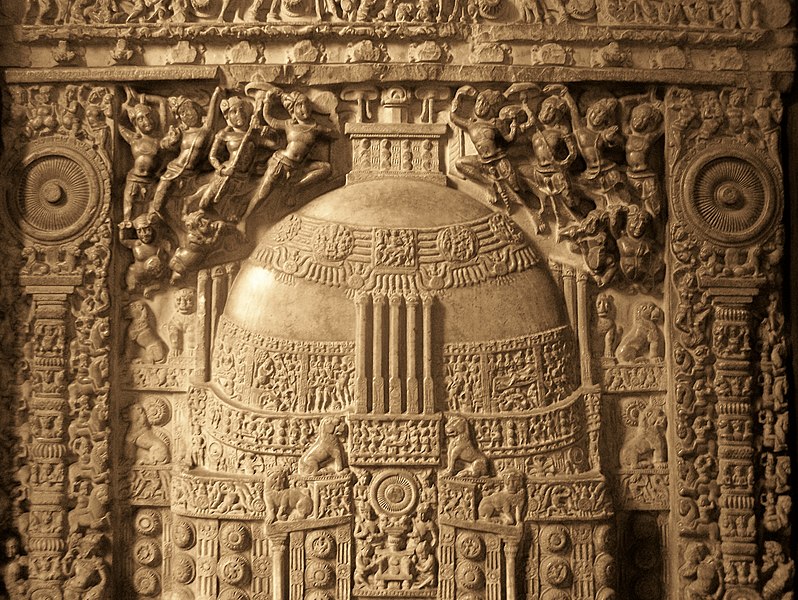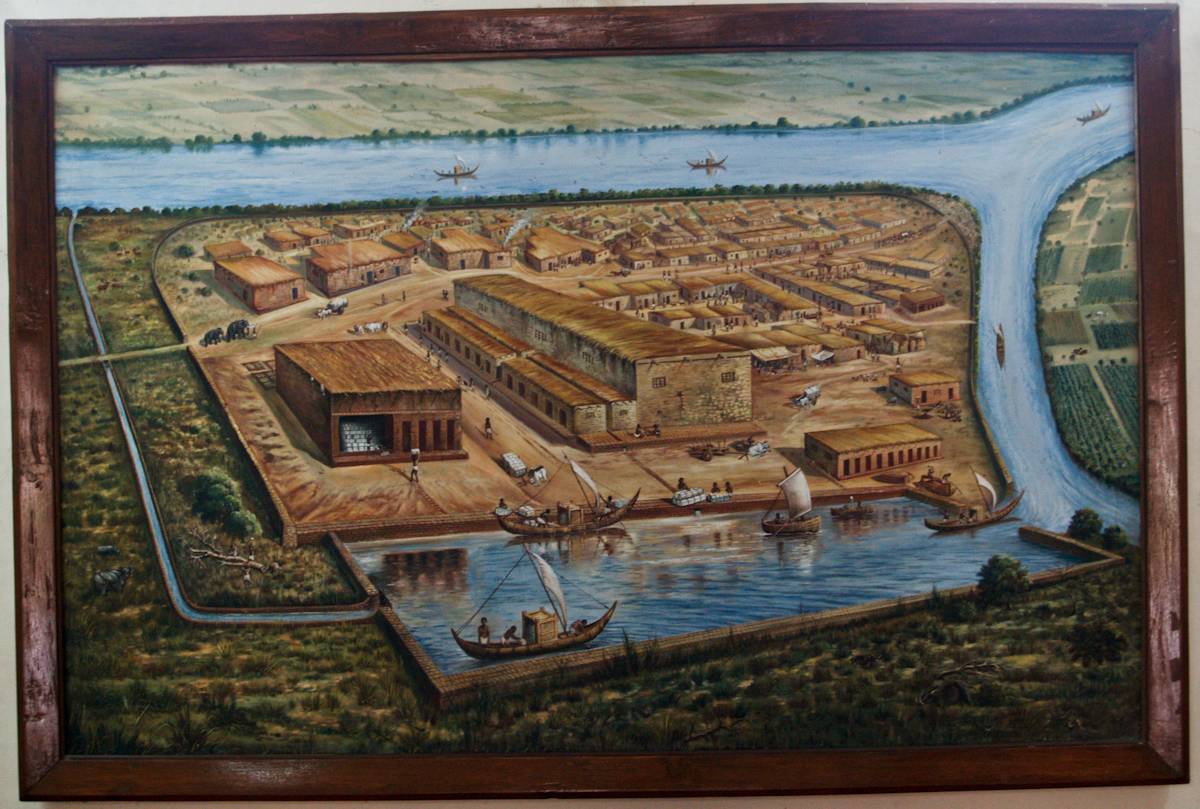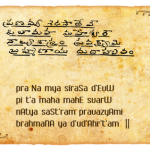Indian Architecture has been the subject of much discussion and debate. Often times, rootless people have a tendency to downplay the native tradition and place emphasis on theorised “foreign contributions” to the Indic Canon. The reality, however, is that there is a long and ancient tradition of not only Art & Architecture, but even City Planning per the Vedic Tradition. In fact, while these are all often grouped under Vaastu Sastra, they are in fact properly categorised under the upaveda known as Sthaapatya Veda.
Introduction
 Much as Sangeeta Sastra & Nrtya Sastra emerged from the Gandharva Veda, so too does our tradition assert that Vaastu Sastra, Silpa Sastra, and Chitra Sastra emerged from Sthaapatya Veda. “It expounds the principles involved in the areas of Vastusastra (Architecture and Planning), Silpasastra (Sculpture and Iconography), Chitrakalaa (Painting in all branches“. [1,1] Just as the Gandharva Veda is attached to the Saama Veda, this upaveda is attached to the Atharva Veda. Further, knowledge of Ayurveda, Gandharva Veda, Jyotisha, and Saamudrika Sastra is also relevant to the field.
Much as Sangeeta Sastra & Nrtya Sastra emerged from the Gandharva Veda, so too does our tradition assert that Vaastu Sastra, Silpa Sastra, and Chitra Sastra emerged from Sthaapatya Veda. “It expounds the principles involved in the areas of Vastusastra (Architecture and Planning), Silpasastra (Sculpture and Iconography), Chitrakalaa (Painting in all branches“. [1,1] Just as the Gandharva Veda is attached to the Saama Veda, this upaveda is attached to the Atharva Veda. Further, knowledge of Ayurveda, Gandharva Veda, Jyotisha, and Saamudrika Sastra is also relevant to the field.
Heartiest greetings to all on planet first divine architect and engineer lord VISHWAKARMA day pic.twitter.com/bHqSE99yYB
— SIDHI NATH (@sidhi0011) September 17, 2017
Central to Sthaapatya Veda is the Sthaapathi (master-architect). Sthaapathoh karma sthapatyam (the work of an architect is Sthaapatya Veda). [4,44] Silpa-Sastra has a section called Sthaapati-lakshana, or the Characteristics of a Sthapathi. It says:
“I am now going to described the Sthaapatya as handed down to us from generation to generation, by the knowing of which the values and defects of the Sthaapati are known”. The Sthaapatya is fourfold— the traditional lore (Sastra), the practical experience (Karma), intuitive insight (Prajna) and the righteous conduct and character [4, 45]
Vishvakarma is considered the originator of this field of study, and Pauranic tradition holds him to the be the Divine Architect. The great cities of Dvaraka and Indraprastha are attributed to his supreme skill in the field of city planning.
For civilized people a comfortable residence is as necessary as food and clothes. In fact the standard of civilization seems to be regulated, amongst other things, by durability, scientific plan, aesthetic construction, and successful finish of buildings, religious, residential or military. [1]
Maanasaara (‘the essence of measurement’, is considered the authoritative and exhaustive text on this topic today. However, the philosophy behind Sthaapatya Veda in general and Vaastu in particular is far more ancient. “The Creative feelings of Rsis, who were attributed to be the authors of the Indian Vaastu and Silpa texts, and the practicing Silpins had to activate the centre called aakaasa or aatman“.[3,17] This aligns very much with the common thread of Dharmic thought across the native Indic traditions.
For ancient Indian writers, at any rate, architecture seems to have been a very fascinating subject, inasmuch as the Vedic, Buddhist, Epic, Pauranic, Agamic, Historical, Political and even Astronomical literature bears traces of it. [1,1]
Theoretical Foundations
As with the Indic tradition in general, the origins of epistemology date back to our most sacred texts. Along with the Vedas, the Puranas, Agamas, and literature from the Buddhist and other Nastika philosophies have all contributed to Indic Art and Architecture. Therefore, an article on Sthaapatya should give space to all of them.
Veda
“The Hymns of the Atharva-veda give some information about the construction of a house.” [1,1] Maharishi Vasishta is recorded to have spoken in the Rig Veda of his wish to have a tri-dhaatu-saranam constructed for him, indicating the varied types of housing even at an ancient date. [4, 51] The Sulba-sutras, which supplement the vast corpus of the Kalpa-sutra literature, discusses the measurement and construction of various vedis (vedic altars). This is often seen as foundation for the origin of Architecture in India. Altars mentioned by Baudhayana and Apastamba reach to the height of 10-15 layers of bricks.
As western scholars would later minimisingly mention, “the authors of the Vedic literature ‘were not ignorant of stone forts, walled cities, stone houses, carved stones, and brick edifices“.[1, 3] This is, therefore, even more so the case with the authors of the Pauranic literature.
Purana
The Mahabharata contains short but comprehensive accounts of the cities of Dvaraka (III.5), Indraprastha (1.207, 30f), a floating city (III.173,3), Mithilaa (III.207, 7) and others.[1,9]
Itihaasa-Purana is valuable source of information for Classical Indic Architecture. While it is averred that many accounts may seem fantastical to our ‘modern’ eyes, they give insight on not only continuity of theory to the present day, but also provide understanding of native inspirations (rather than the current obsession with native implementations of foreign inspiration).
The Epics furnish copious description of cities, storeyed buildings, balconies porticos, triumphal arches, enclosing walls, flights of stone masonry steps for tanks and a variety of other structures, all indicative of a flourishing architecture in the country [of India]. [1,8]
Perhaps the most famous account of City Construction in the Epics was that of ancient Indraprastha (modern Delhi). From the clearing of Khandavaprastha forest to the yagna performed for its construction, to its design and implementation by Vishwakarma, to even its beguiling wonders that caused Duryodhana to fall and Draupadi to laugh, one sees the start, completion, and effects of such beautiful municipalities.
Notably, the city plan of Ayodhya is ‘strikingly similar’ to the town-plan listed in the Maanasara and various other Architectural treatises. “The temples (devaayatana) in this city (Ayodhya) were as resplendent as the sky. Its assembly-halls, gardens, and alms-houses (prapaa) were most elegant; and everywhere were arranged extensive buildings crowded with men and women……..The houses were as mines of gems, and the abodes of the goddess of fortune. The steeples (sikhara) of the houses were as resplendent as the crests of mountains and bore hundreds of pavilions (vimana) like the celestial palace of the chief among the Devas. The rooms were full of riches and corn, exquisitely gilt and decorated, and seemed as charming as pictures; and they were so arranged that men could pass from one room to another without perceiving any inequality.” [1, 9]
While the Ramayana and Mahabharata are traditionally classified under Itihasa, the Puranas proper (said to number 108) provide a wealth of information on the science of Art & Architecture proper. The Matsya purana has 8 expansive sections discussing Vaastu and Silpa in great detail. One entire chapter is dedicated to the pillar, which is considered ‘the regulator of the whole composition of a building’. 5 styles of columns with 8 different mouldings are described. The other chapters focus on silpa and discuss taalamaana (proportionate measurement of images). Skanda purana has 3 chapters dedicated to it, and makes mention of construction of a golden hall, special pavilions for the wedding of a princess, and even chariots. The Garuda purana comprehensively discusses the 3 main types of buildings: religious, residential, and military. Layouts of temples, palaces, pleasure-gardens, fortresses, and fortified cities are all reviewed. Murthi-sthaapana (installation of religious icons) are also discussed. These are performed by a Sthaapaka (architectural priest) distinct from Sthaapathi (professional architect). [1, 11]
Finally, the Agni Purana of all the Puranas, allocated the greatest length to Sthaapatya Veda. It devotes 16 chapters to town-planning, 2 chapters with residential building, and 13 for sculpture. That temples are again discussed here shows the antiquity of temples to Sanatana Dharma itself. There are of course other puranas which treat on the topic, such as the Naarada, Linga, Vaayu, and Varaaha, but there are all better expounded upon elsewhere.
The most notable of the minor puranas is the Vishnudharmottara. It extensively covers the Artistic tradition of India, with special emphasis on sculpture and painting.

Agama
The agamas are critical text to the Vedic tradition that are still used today for both temple construction and temple management. Though legend asserts that there were once countless agamas, today there are about 200, with 3 Main categories: Vaishnava (108), Shaiva (28), and Shakta (64). In fact, from these are collected the 64 Tantras (but that is a topic for another time).
The Kaamikaagama dedicates 60 of its 75 chapters to Architecture, Sculpture, and Painting. It is a highly technical and systematic text (much like the Silpa Sastra) and deals with matters such as soil testing and preparation, selection of sites, measurement scheme and cardinal points for building orientation, as well as ground plans. 20 different types of buildings are mentioned. It also provides exceedingly technical classifications such as the various styles (Nagara, Dravida, and Vesara), shapes (masculine, feminine, and neuter), materials (Suddha, Mishra, and Samkeerna), amalgamation of materials (Sthaanaka, Aasana, and Sayana), as well as various ayadi formulae regarding proportionality. [1, 13]
The Karanaagama allocates much of its treatment to Sthaapatya Veda, with 37 chapters on the subject. The Suprabhedaagama dedicates 15 chapters, but is highly useful for laypeople due to its brevity, clarity, and precision. It is deemed superior to Varahamihira‘s Brhat Samhita in such matters and has much in common with the Maanasaara. Finally, the Vaikhaanasaagama has 2 chapters on sculpture and various taala measures.
There are other Indic texts discussing various topics under Sthaapatya Veda. These include the Arthasastra of Kautilya, the Harsacharita of Bana, the Garga-samhita, and so on. Poetry, such as Bhavabhuti’s Uttaramacharita also mention aspects of Sthaapatya, as does Yaaska’s Nirukta and other subsequent compilations such as the Amarakosa.
However, this is also a unique point of divergence as we see along with the Astika Vaidika Dharma tradition, the Bauddha Dharma contribution to the Indic concepts of Art & Architecture.
Bauddha
“In the Buddha’s time and in that portion of northern India where the Buddhist influence was most early felt—that is to say, in the districts including and adjoining those now called the United Provinces and Behar’—the arrangements of villages were practically similar…Villagers are described as ‘uniting of their own accord to build mote-hills and rest-houses and reservoirs, to mend the roads between their own and adjacent villages, and even to lay out parks.'” [1,3]
The stupa is arguably the most famous contribution of Bauddha Dharma to Indic Civilization. Amaravati, Sarnath, Sanchi, Naalanda, and Takshasila all feature constructions famous the world over. While much of it is naturally an outgrowth of the Vedic Canon, the Buddha himself appears to have been a progenitor of a distinct approach to architecture. “At places it appears as if Buddha were delivering discourses on architecture. As a matter of fact, he enjoined upon his devotees the supervision of building construction as one of the duties of the order. It is stated in one of the early texts that the Bhikkhus were told on a certain occasion by the Blessed One, after the delivery of a religious discourse, with respect to dwellings, thus: ‘I allow you O Bhikkus, abodes of five kinds—Vihara, Arddhayoga, Praasaada, Harmya, and Guhaa’.” [1,4]
Viharas are the famous grand monasteries of the Bauddhas, Ardhayoggas are considered to be unique to Vanga (Bengal) and were part ceremonial and part residential. Praasaadas are purely residential multi-storied constructions. Harmyas are more humble versions of praasaadas, and Guhas are part underground cave constructions, which are famous through India. These of course often feature the Chaitya halls known in rock-cut cave architecture. Just to give insight into the timescales associated with their completion, a small Vihara was said to take 5-6 years and a large Vihara or Prasada 10-12 years.
Houses were built comprising ‘dwelling-rooms and retiring-rooms, and store-rooms, and service halls and halls with fire-places in them, and store-houses,, and closets, and cloisters, and halls for exercise, and wells, and sheds for the well, and bath-rooms, and halls attached to the bath-rooms, and ponds, and open-roofed sheds.” [1,4-5]
There was also mention of pavilions, lotus ponds, and inner chambers of 3 types: Sivikaa-garbha (square halls), Naalikaa-garbha or rectangular halls, and Harmya-garbha (large dining halls). Gates, doors, screens, and revolving doors are all mentioned. We also find discussion of various types of furniture such as divans (pallanka), rectangular chairs (aasandako), sofa (sattango), state chair (bhadda-peetam), cushioned chair (paeetikaa), cane-bottomed chair (koccham) and so on. There is also description of carpets, rugs, pillows, and other such accents and fixtures.
Literature providing insight into the Buddhist approach to architecture includes the Jatakas, the Nikayas, various Sutras such as the Mahaa-Suddassana.

Key Concepts
There are a vast and variegated number of concepts associated with Sthaapatya Veda, given its status as a meta-category for Art & Architecture. As this article is meant to primarily provide a snapshot for readers, it will be more restricted in coverage.
Any object is a vastu, hence any creation deriving from an object is Vaastu. Vaastu literally means “site planning”. [2] As such subjects discussed below include home planning, municipality planning, and public hygiene.
Home Planning
Land Type
There are 16 types of Lands. They are classified under forest lands, fertile lands and ordinary lands. One that is fertile, verdant, full of hills and valleys all around, contains tall and “sweet scented trees and shrubs, where the atmosphere is serene, cool, and calm, where songs of birds abound, such a location is ideal for the selection of a dwelling site.” [1, 17]
Soil Type
Per the Maanasaara, “the ground should have sweet, dense, soft, and pleasant soil.” [1,17]
Ground to be avoided include those having the smell of honey, ghee, burnt items, birds, fish, or rotten bodies, those adjacent to Royal palaces or factories or workshops, road crossings, tomb, thorny trees, uneven surface, circular/concave land, and those infested by wild animals. Suitable ground is characterised by “having various colours, taste, fertile, redolent like musk by black bees, having all good features“, sloping hills and ponds in the right directions, and so on. Such a plot of land should be selected and purified. [1,18]
Each House plan is divided into x number of plots. Each set of plots is dedicated to a deity (such as Brahma, Indra, Vivasvan, and so on). Various directions and sets of plots are specified as ideal for certain occupations. It is said that water bodies should be made in the North East, South/Southwest suitable for dining halls, etc. Specification for bedrooms, study rooms, treasuries, and rooms for amusements, and flower gardens are also made on the basis of plot set. Proportionality (something modern Indians lack in behaviour) is mandated everywhere.
Rituals
There is a specified ritual for commencement of construction. Jyotisha should be consulted to determined the auspicious moment, followed by bath and prayers. A Sthaapathi (Architect) should also be consulted. Following this, erection of the gnomon (similar to a sundial)and pegs can be done with the assistance of a surveyor. There are 3 types of gnomons. These are long, middle and smaller.
Construction
“At the centre of the prepared site a circle having a radius double that of the selected gnomon should be drawn using a chord. The gnomon should be firmly fixed at the centre of the circle.” [1, 19] It’s quite clear from descriptions from the Maanasaara, that not only Jyotihsastra, but even Ganita that was crucially & carefully applied by the Sthaapathis.
Municipality Planning

Urban planning of the Indic variety did not merely focus on urban areas and forts. Towns and even villages were meticulously planned and established. As such, what is called city planning is better termed municipality planning, since even ancient Indic villages not only conformed to certain patterns, but had specified plans for development and maintenance.
32 ground plans are given in the Maanasaara for the construction of buildings, villages, towns, palaces, and forts. Rather than give an exhaustive list here, the construction types will be covered instead
Villages
Per Sthaapatya Veda, there were 8 types of Villages. A separate exegesis on Vaastu Saastra will better cover the topic. Nevertheless, here is a brief overview:
- Dandaka—suited for agraharas, with 12-300 houses, including some for munis.
- Sarvotabhadra—another village type suitable for aescetics (Vedic, Jain, Buddhist), but in this case housing all classes of people with different occupations. Mathas may also be constructed here.
- Nandyaavarta—meaning frog-shaped, this type of village may even feature royal residences. Streets here are larger and feature footpaths as well. Residences for musicians and dancers are also specified.
- Padmaka—Has 4-8 streets. Generally follows the pattern of the nandyaavarta.
- Svastika—This village type has 81 plots and is particularly purposed for the residence of kings. Naturally the main street shape is in the design of a Svastika.Has a royal palace, with residential buildings laid out around temples
- Prastara—with 81, 64, or 49 plots, this village type is square-shaped. There is a circular road, and it is ideal as fortified trading municipality.
- Kaarmuka—This village type is ideal for mercantile and productive classes. Vishnu and Siva temples are stipulated for construction at the junction of 2 streets.
- Chaturmukha—Square or rectangular in layout, it has four main streets in four cardinal directions, with a round boundary wall. This village type can be purposed for all ways of life.
Reading various texts of Sthaapatya Veda, the ideal of the Village Republic becomes clear. The first priority is made for defence. Each village was expected to be surrounded by a high wall of brick or stone, along with a ditch beyond it to serve as an obstacle in the event of an attack. Four main gates are considered the standard with 2 intersecting N-S and E-W streets. Often one for circumambulation of the entire village is also advised. Tanks and ponds are also mentioned. Houses in the street could range from 1 to 12 storeys. [1,39] The main point was that residential houses should be located in areas without street congestion from traffic. In addition, murthi-sthaapana was to take place only during festivals or special occasions, and with proper religious rituals and honours. [1, 38]
Most notable, however, is that provision is made not only for village planning but re-planning! “In the case of replanning a village, the architect or town planner should follow the order laid down for all villages.” [1,39] And for those who believe Hindus have no sense of heritage, here is a specific exhortation for village re-planning: “if there is any ancient building or temple in the village it should be retained and preserved.” [1, 39]
Cities

City and town planning are admittedly more complex. These were categorised based on who resided in the area, the most important being the ruler of the particular polity. There were 9 categories for cities based on 9 types of rulers: Astragrahin, Praharaarka, Pattaabhaj, Mandalesa, Pattaadhara, Parshnika, Narendra, Maharaja, Chakravartin. These in turn had various sub-categories.
The other set of cities are simply known as Nagara or Kevala:
- Nagara/Kevala—City with four gates in the cardinal directions. Army barracks and guard quarters with temples and markets.
- Pura—Without a royal palace. It has many gardens and orchards for people of the various varnas. It is a centre of trade and commerce, with temples for worship
- Nagaree—A city near a mountain or river. It should have a wall for protection
- Kharvata—A city near pasture lands with mixed population
- Kheta— A forest municipality inhabited by hunters
- Kubjaka—A town with diverse types of people. It does not have a defensive wall
- Pattana—A citadel near a river (much like Mohenjo-daro)
Forts were categorised as Sivira (camp or outpost), Vahinimukha (city with defence establishments), Sthaniya (strategic city near mountains/passes), Dronaka (fortified town built on banks of a river for commerce), Samviddha (town for brahmins), Kolaka (a samviddha with a palace for the king), Chaari/Nigama (town primarily for religious and commercial purposes), and Skandhavara (fortified town for kshatriyas). [1, 44]
There are of course the traditionally specified types of fortresses, which are 7 in number: Mountain fort (giri durgam), Forest fort (vana durgam), Water fort (jala durgam), Clay/Cave fort (panka/guha durgam), Chariot fort (ratha durgam), Divine fort (divya durgam, has extensive fortress with efficient defensive system), and Mixed fort (mishra durgam, situated among both both mountains and forest). [1, 45]
Temple construction is a topic of its own.

Given the technicality, Temple construction is better dealt with again under Vaastu Sastra. Not to play to the gallery by saying “pehle sauchalay, phir devalay“, (which should really not be an either or proposition…) but another critical aspect to discuss is the emphasis on public hygiene. Modern Indian municipalities may not be known for this (the cost of Colonialism), but ancient India certainly was.
Interestingly, not just cities, but even villages had to plan for hygiene, drainage, and catchment.
Drainage & Hygiene
With the passage of time and the efforts of archaeologists, it’s becoming more and more difficult to deny the greater and greater similarities between the Vedic culture that is recorded (and still lived today) and the ever increasing discoveries of the scale and spread of the Indus Valley Civilization, so much so, that it is increasingly being called the Sarasvati-Sindhu Civilization. This, of course, dovetails with the Vedic Tradition itself, which asserts the Sarasvati-Sindhu (Brahmavarta) as the original home of all Indians.
Given the likelihood of this, and texts such as the Arthasastra which specify the high degree of regimented and disciplined public hygiene, Harappa and Mohenjo-daro are very much emblematic of Sthaapatya Veda’s emphasis on the same. If these cities in Sindhu desh show the urban plan of drainage, Sthaapatya Veda describes it right down to the village level.
It is also no wonder that Ayurveda is closely associated with it. “According to Sthaapatya Ved it is imperative to known about other various valuable effects to the environment given out by various types of trees, plants, shrubs and herbs, etc. This has been studied methodically and their effects to human physiology have been stated. This is effectively used in planning a garden around a home, planting trees around a village, public gardens and tree in the cities. The trees and plants have been classified according to the location of their use.” [1, 48]
Vriksha Ayurveda, due to it extensive nature, is again, better discussed elsewhere. Nevertheless, this dovetails into the key terms for the topic.
Terminology

- Vaastu Sastra—Study of Architecture & City Planning
- Silpa Sastra—Study of Sculpture & Iconography
- Chitra Sastra—Study of Painting
- Chitra lakshana—Painting
- Taksana—Carpentry
- Rajadhani— Capital City
- Graama— Village
- Thorana—Arch
- Devaayatana—Temple
- Sabha—Assembly Hall
- Sikhara—Steeple
- Gala—Dome
- Uttara—Lintel
- Jaala—Jali (screen/lattice)
- Gopura—Tower
- Garbagriha—Sanctum Sanctorum
- Praasaada—Palace
- Vimaana—Pavilion
- Visesha Bhavana—Palace of Beauty
- Marga—Road
- Manusyalaya—Residence
- Aarama—Guest house
- Alinda—Verandah
- Prakaara—Ramparts
- Parikha—Moats
- Kapisirsaka—Battlements
- Kautukalya—Museum
- Silpasala— Art House
- Istaka—Brick
- Stambha—Pillar
- Dvara—Door
- Kaksa—Room
- Gavaaksa—Window
- Attaalika—Edifices/Buildings
- Sthaapathi—Architect
- Sthaapaka—Presiding priest at an architectural site
- Silpi/Bhaskara—Sculptor
- Chitrakaara—Painter
Important Texts
Vishvakarma Vastu Sastra
Vishvakarma Prakasa
Vishnudharmottara Purana
18 Mahapuranas (Matsya, Skanda, Garuda, Agni, etc)
Silpa Sastras
Silpa Ratna
Brihat Samhita of Varaahamihira
Maanasaara
Mayamata
Agamas, ie Kaamikaagama, Karanaagama, Suprabhedaagama & Vaikhaanasaagama
Suryasiddhanta
Siddhanta-shiromani
Samarangana Sutra of King Bhoja
Aparaajita-Prcchaa of Bhuvanadevacharya
Leelavati of Bhaskaracharya (mentions architecturally important concepts)
Conclusion
5th Century "Dashavatara Vishnu Temple", Deogarh, UP is a great example of early Gupta architecture of #GuptaEmpire pic.twitter.com/d6RhQactIs
— #TemplesOfIndia (@TheIndianTemple) October 31, 2015
Much like virtually every field of study—even contribution—in Indic Civilization, Indian Art & Architecture is also subject to great controversy. On the one hand, western and western-sponsored “scholars” seek to minimise and question every accomplishment, be it intellectual or architectural, and on the other hand, the atisayokti-prone argumentative Indian reacts in grand hyperbole (“Taj Mahal was Shiva temple!“—[even this theory guys, asserts it was a palace that housed a Shiva Temple…details matter].
Marxist “historians” have only complicated matters more by inventing schools that didn’t previously exist “Indo-saracenic”, and crediting everything under the sun (pillars, domes, screens, even temples!) to foreign invaders. Finally, foreign invaders themselves gleefully catalogued their vandalism and iconoclasm that resulted in the destruction of many beautiful palaces and temples. Ghazni himself waxed eloquent on the wondrous temple of Mathura, saying it would take 200 years to build such a magnificent and glorious structure—before he proceeded to rob it of its inlaid gold and gems and burn it down with sulphur and naphta. Self-proclaimed “seculars” engage in all sorts of denialism of such realities, despite widespread primary source evidence. How can a person interested in facts, and Historical Truth, navigate his or her way through such a quagmire?
The answer lies in starting from the roots. And the roots of Indian Art & Architecture (real Indian Art & Architecture) are in Sthaapatya Veda.
Hindus had codified every branch of knowledge in some kind of Saastra and we had a Saastra on Art also. Among many Vedas and Upa-Vedas there was a Sthaapatya-Veda. Accordingly Hindu Art had a very vast scope in which Fine Arts, Technical Arts and Applied Arts, all were included. We had a full-fledged science which was called Shilpasasatra or Vaastusaastra. We had also a tradition of Kalaas what are known as ‘Catussastri-kalaas” [2, 1]

As seen above with the Srirangam temple and also with the Vedanga Jyotisha, most of the traditional sciences in Indic Epistemology have an holistic unity. Architecture, Sculpture, and Painting are seamlessly integrated not only with themselves, but also with Ganita and Jyotihsastra. Many of course naturally protest saying the mythological and metaphysical should be kept apart from the modern and material. But in fairness, is that always the case?
Are the findings of Dvaraka real? —maybe. Are the roots of the Sarasvati-Indus Valley, Vedic?—possibly. But the answer to whether or not there was a native and ancient Indic approach to Art & Architecture should certainly be “definitely”. And that Indic approach to Art & Architecture is found in Sthaapatya Veda.
References:
- Gaur, Niketan. Sthapatya Ved-Vastu Sastra: Ideal Homes, Colony and Town Planning. New Delhi: New Age Books. 2009
- Shukla, Lalit Kumar. A Study of Hindu Art and Architecture (with special reference to the terminology). Chowkhamba. 1972
- Singh, B. Satyanarayana. The Art and Architecture of Kakatiyas.Delhi: Bharatiya Kala Prakashan. 1999
- Shukla, D.N. Hindu Science of Architecture (Vol. I). New Delhi: Munshiram Manoharlal Publishers. 2008










